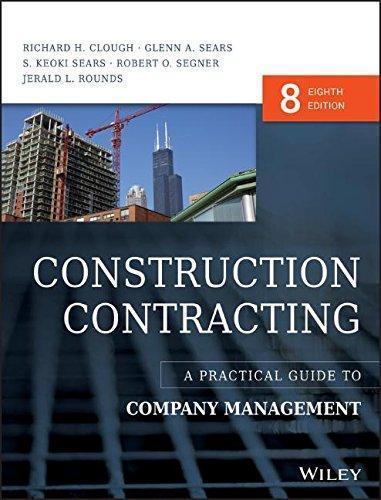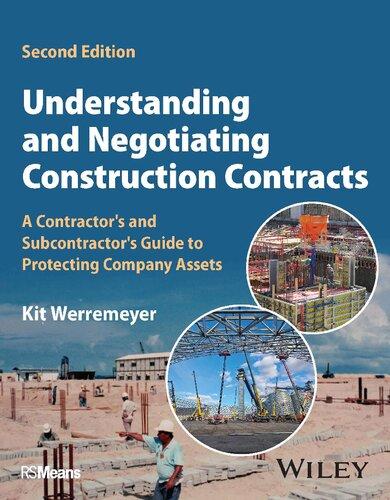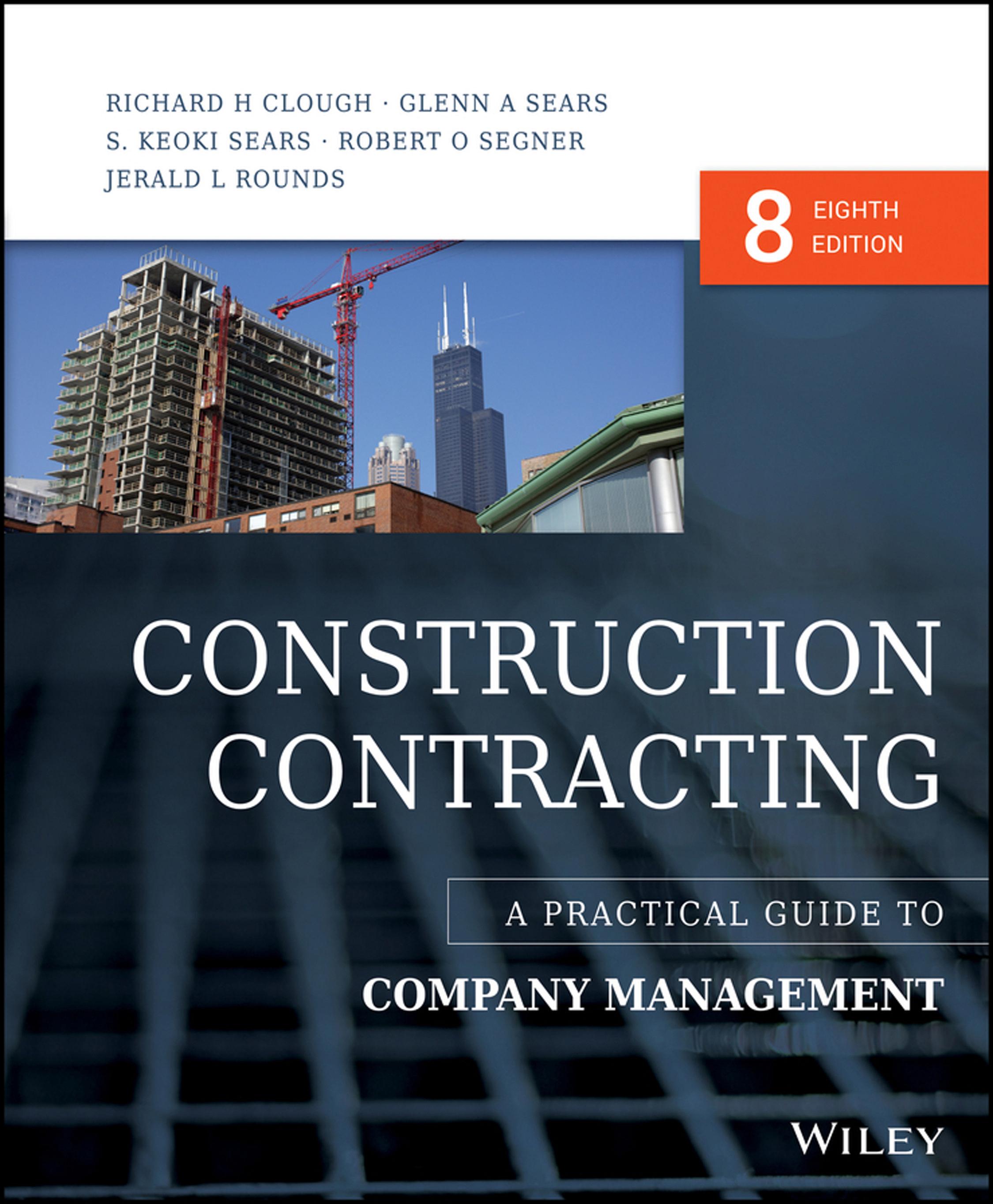Visit to download the full and correct content document: https://ebookmass.com/product/construction-contracting-a-practical-guide-to-compan y-management-8th-edition/

More products digital (pdf, epub, mobi) instant download maybe you interests ...

Nonclinical Study Contracting and Monitoring: A Practical Guide 1st Edition
https://ebookmass.com/product/nonclinical-study-contracting-andmonitoring-a-practical-guide-1st-edition/

Dental Practice Transition: A Practical Guide to Management 2nd Edition
https://ebookmass.com/product/dental-practice-transition-apractical-guide-to-management-2nd-edition/

Understanding and Negotiating Construction Contracts: A Contractor's and Subcontractor's Guide to Protecting Company Assets 2nd Edition Kit Werremeyer
https://ebookmass.com/product/understanding-and-negotiatingconstruction-contracts-a-contractors-and-subcontractors-guide-toprotecting-company-assets-2nd-edition-kit-werremeyer/

Conflict Management: A Practical Guide to Developing Negotiation Strategies Barbara A. Budjac Corvette
https://ebookmass.com/product/conflict-management-a-practicalguide-to-developing-negotiation-strategies-barbara-a-budjaccorvette/

International Financial Reporting: A Practical Guide 8th Edition Alan Melville
https://ebookmass.com/product/international-financial-reportinga-practical-guide-8th-edition-alan-melville/

Practical Guide to Clinical Data Management 3rd Edition – Ebook PDF Version
https://ebookmass.com/product/practical-guide-to-clinical-datamanagement-3rd-edition-ebook-pdf-version/

Sedation: A Guide to Patient Management 6th Edition
https://ebookmass.com/product/sedation-a-guide-to-patientmanagement-6th-edition/

A Practical Guide to Geriatric Neuropsychology Susan Mcpherson
https://ebookmass.com/product/a-practical-guide-to-geriatricneuropsychology-susan-mcpherson/

Contracting for Design and Construction Services in the Public Sector John O. Adler
https://ebookmass.com/product/contracting-for-design-andconstruction-services-in-the-public-sector-john-o-adler/

theownerwithintheconstraintsoftheowner’sbudget.Thecontractorsetsupaproductionoperation ontheconstructionsiteand,toalargeextent,custom-buildseachproject.
Theconstructionprocessissubjecttotheinfluenceofnumeroushighlyvariableandoftenunpredictablefactors.Theconstructionteam,whichincludesvariouscombinationsofcontractors,owners, architects,engineers,consultants,subcontractors,vendors,craftandmanagementworkers,sureties, lendingagencies,governmentalbodies,insurancecompanies,andothers,changesfromoneproject tothenext.Allofthecomplexitiesinherentindifferentconstructionsites,suchassubsoilconditions, surfacetopography,weather,transportation,materialsupply,utilitiesandservices,localsubcontractors,andlocallaborconditions,areaninnatepartoftheconstructionproject.
Asaconsequenceofthecircumstancesnotedabove,constructionprojectsaretypifiedbytheir complexityanddiversity,andbythenonstandardizednatureoftheirdesignandconstruction.Despite theuseofprefabricatedunitsincertainapplications,itseemsunlikelythatfieldconstructioncan evercompletelyadaptitselftothestandardizedmethodsandtheproductuniformityofassembly-line production.
1.3ECONOMICIMPORTANCE
Foranumberofyears,constructionhasbeenthelargestsingleproductionindustryintheAmerican economy.Itisnotsurprising,therefore,thattheconstructionindustryhasagreatinfluenceonthe stateofthisnation’seconomichealth.Infact,constructioniscommonlyregardedasthecountry’s bellwetherindustry.Timesofprosperityareaccompaniedbyahighnationallevelofconstruction expenditure.Duringperiodsofrecession,constructionisdepressed,andthebuildingofpublicly financedprojectsisoftenoneofthefirstgovernmentalactionstakentostimulatethegeneraleconomy. Whentheconstructionindustryisprospering,newjobsarecreated,bothindirectemploymentinconstruction,aswellasinrelatedindustries,suchasmaterialsandequipmentmanufacturingandsupply. Ahighlevelofconstructionactivityandperiodsofnationalprosperityaresimultaneousphenomena; eachisanaturalresultoftheother.
SomefactsandfigurespertainingtoconstructionintheUnitedStatesareusefulingaininginsight intothetremendousdimensionsofthisvitalindustry.Thetotalannualvolumeofnewconstruction inthiscountryatthepresenttimeisapproximately$1.75trillion.Theannualexpenditureforconstructionnormallyaccountsforabout10percentofthedollarvalueofourgrossdomesticproduct. Approximately80percentofconstructionisprivatelyfinanced,and20percentispaidforbyvariouspublicagencies.TheU.S.DepartmentofLaborpresentlyindicatesthatconstructioncontractors directlyemploymorethan7millionworkersduringatypicalyear.Iftheproduction,transportation, anddistributionofconstructionmaterialsandequipmentaretakenintoaccount,constructioncreates, directlyorindirectly,about12percentofthetotalgainfulemploymentintheUnitedStates.
1.4THEPEOPLEINVOLVEDONACONSTRUCTIONPROJECT
Constructionprojectsaredesignedandbuiltthroughthecombinedeffortsofanumberofpeople. Eachhasadefinedroleandasetofaccompanyingresponsibilitiesinthetotaleffort.Theseroles,as wellastherightsandresponsibilitiesofthosewhoparticipateintheprocess,aredefinedincontracts thatareformedbetweenthevariousparticipants.
Whiletheconstructionindustryisoftendescribedintermsofmaterials,suchasconcrete,steel, masonry,andmanyothers,orintermsofprojectdeliverysystemsandcontractingmethods,itcan alsobetypifiedintermsofthepeoplewhointeractintheprocesswhichresultsinacompletedproject.
Itisthepeoplewhoareinvolvdinthedesignandconstructionofaprojectwhobringtheprojectto fruition.Constructioncontractingcanthereforebestbecharacterizedasapeople-orientedbusiness andprofession.
1.4.1Owner
Theowneristhecentralfigureinanyconstructionproject.Theownercanbedefinedmostdirectly asthepersonwhowillown—literallywillhavetitleto—theprojectuponitscompletion.Theowner isalsothepersonwhowillpayforthedesignandconstructionoftheproject.
Itistheownerwhoinitiatesallthatwillfollowinthedesignandconstructionprocesses.The inceptionofanyconstructionprojectbeginswiththeowner’srecognitionofaneedforaconstructed project,whetheritbeanewbuildingoranexpandedorrenovatedbuildingorafacilitysuchasa highway,industrialplant,orairport.Mostownersperceivethisneedandrefineitsramificationsover aperiodoftime,untilatsomepointthedecisionismadetomoveforwardwiththeidea.
Typically,theownerwillnextthinkintermsoffinancing—howmuchmoneyheiswillingor abletocommittosatisfythisneed.Additionally,thesourceofthesefundsisconsideredandanalyzed. Determinationsaremaderegardingwhethertheforthcomingprojectwillbefundedwithowner’s fundsorwithborrowedcapital.Mostownerswillmakeatleastapreliminarydeterminationduring thecourseofthisprocess,withregardtothemaximumnumberofdollarstheowneriswillingorable tospendforthedesignandconstructionthatwillsatisfytheneedthathasbeenperceived.Thisvalue willbecometheowner’sbudgetfortheproject.
Mostownerswillnextseektheservicesofadesignprofessional—anarchitectorengineer.The ownerwilllooktothispersontoassistwithdefiningandcodifying,indetail,whattheowner’sneeds are.Thentheownerwillexpectthedesignertoproduceadesignthatwillsatisfytheneedsofthe owner,withintheconstraintoftheowner’sbudget.
Variousmethodsareemployedbyownerstodeterminewhothedesignerwillbe.Theowner mayhaveafamiliarity,orahistoryofpastperformance,withacertaindesignerordesignfirm.Alternately,theownermayseekinputfrompeersandacquaintancesregardingcompetentdesignfirms. Sometimes,theownermaystageadesigncompetition,wherebyhesetsforththeparametersofhis need,andinvitesdesignprofessionalstosubmitdesignsincompetitionwithoneanotherforselection bytheownertodesigntheproject.Theseandothermethodsoftheowner’schoosingthefirmthat willproducethedesignarefurtherdiscussedlaterinthisbook.
Itisimportanttonotethattheownerwillselectadesignfirmandthenwillenteracontractwith thatfirm.Thecontractwillsetforththeexactnatureoftheservicesthatthedesignerwillprovide, andwillcontainprovisionsrelativetodeterminationandpaymentofthedesigner’sfees,alongwith definingalloftheadministrativeelementsoftheagreementbetweentheseparties,aswellastherights andobligationsofthetwoparties.Theexistenceofanactualcontractbetweentwopartiesisreferred toastheirhavingprivityofcontractwitheachother.Theconceptofwhohasprivityofcontractwith whomonatypicalconstructionprojectisfurtherdiscussedinsucceedingsectionsofthischapter. Likewise,detailsregardingthetypicalcontentofthecontractbetweentheownerandthedesigner willbefurtherdiscussedinanotherchapter.Themostcommonrelationshipbetweentheownerand thearchitect-engineer,aswellasthenamesoftheotherpartiesmostcommonlyinvolvedinthedesign andconstructionofaproject,andwhohasprivityofcontractwithwhom,areillustratedinFigure1.1.
Ownersmaybecharacterizedasbeingprivateownersorpublicowners,andtheconstruction projectsthataredesignedandconstructedforthemaredescribedinthesameterms.Privateowners maybeindividuals,partnerships,orcorporations.Thefundsthatareusedtopayforthedesignand
Contractual Connections and Hierarchy of Construction Contracts on a Typical Construction Project
Construction Manager (sometimes)
General Contractor Owner
ArchitectEngineer
SubcontractorSubcontractor
Subcontractor
Sub-Subcontractor Second Tier Subcontractor Consultant
(Arrows indicate Privity of Contract)
Consulting Engineer
Note that the contracts between the parties as illustrated here are in a hierarchical arrangement, with the owner at the top of the hierarchy.
The solid lines (arrows) between parties represent the existance of privity of contract, that is, the existance of an actual contractual connection between the parties. In the method of project delivery depicted here, there is privity of contract between the owner and the architect, and there is privity between the owner and the prime contractor, while there is no privity of contract between the architect and the prime contractor or the owner and the subcontractor.
Figure1.1 PeopleInvolvedandHierarchyofContractsonaTypicalBuildingConstructionProject
constructionoftheprojectareprivatefunds,thatis,notpublicorgovernmentfunds.Mostprivate ownershavestructuresbuiltfortheirownuse:business,habitation,pleasure,orotherwise.However, someprivateownersdonotintendtobecometheendusers.Suchownersintendthatthecompleted structureistobesold,leased,orrentedtoothers.
Publicownersaredefinedassomelevelofgovernment—national,state,countyorparish,municipal,orschooldistrict—orsomeagencyordepartmentofgovernment.Publicownersrangefrom agenciesofthefederalgovernmentdownthroughstate,county,andmunicipalentities,toamultiplicityoflocalboards,commissions,andauthorities.Constructionprojectsthataredesignedand constructedforpublicownersaredefinedaspublicprojects.Suchprojectsarepaidforbyappropriations,bonds,taxlevies,orotherformsofpublicfunding,andaredesignedandbuilttomeetsome definedpublicneed.Publicownersarerequiredtoproceedinaccordancewithapplicablestatutesand administrativedirectivespertainingtoallaspectsofthedesignandconstructionprocess.
Mostownersrelegatebycontractthedesignoftheirprojectstoprofessionalarchitectureor engineeringdesignfirms,andawardcontractsfortheconstructionoftheirfacilitytoconstruction contractors.However,therearesomeownerswho,forvariousreasons,electtoplayanactiverolein thedesignand/ortheconstructionoftheirprojects.
Forexample,someownersperformtheirowndesign,oratleastasubstantialportionofit.Insimilarfashion,someownerschoosetoactastheirownconstructionmanagersorperhapseventoperform theirownconstruction.Manyindustrialandpublicownershaveestablishedtheirownconstruction organizationsthatworkactivelyandcloselywiththedesignandconstructionoftheirprojects.These conceptsarefurtherdiscussedinothersectionsofthischapter.
1.4.2TheArchitect-Engineer
Thedesignerordesignfirm,alsoknownasthedesignprofessional,istheparty,organization,orfirm thatdesignstheproject.Botharchitectsandengineersarelicenseddesignprofessionals.Becausethe designoffacilitiesisarchitecturalorengineeringinnature,andisoftenacombinationofboth,the term architect-engineer isusedinthisbooktorefertotheprimarydesignprofessional,regardlessof theapplicablespecialtyortherelationshipbetweenthedesignerandtheowner.
Thearchitect-engineercanoccupyavarietyofpositionswithrespecttotheownerfor whomthedesignisproduced.Thetraditionalandmostcommonarrangementisoneinwhichthe architect-engineerisaprivateandindependentdesignfirmthatproducestheprojectdesignbythe termsofacontractbetweentheownerandthearchitect-engineer.AppendixB,AIADocument B101–2007,“StandardFormofAgreementbetweenOwnerandArchitect,”providesanexample ofatypicalcontractthatmightbeenteredbetweentheownerandanarchitect,aswrittenbythe AmericanInstituteofArchitects(AIA),whichistheprimarynationalprofessionalassociation forarchitects.
Manypublicagenciesandlargecorporateownersmaintaintheirownin-housedesigncapability.Insuchinstances,thearchitect-engineerisafunctionalpartoftheowner’sorganization. Inotherinstances,theownercontractswithasinglepartyforbothdesignandconstructionservices,inanarrangementreferredtoasdesign-constructordesign-build.Inthisarrangement,the architect-engineerisabranchof,orisaffiliatedinsomewaywith,theconstructioncontractor.
Therearealsoarrangementswherelargeindustrialfirmshavechosentoreducetheirin-house designstaffsandhaveestablishedpermanentrelationshipswithoutsidearchitect-engineers.Such “corporatepartnerships”callonthearchitect-engineertoprovideabroadrangeofdesign,engineering,andrelatedservicesonanopen-endedbasis.Sucharrangementsaresaidtoworktoanowner’s advantagebyfosteringateamapproachandreducinglitigationbetweentheparties.
1.4.3EngineeringConsultants
Aswasnotedintheprevioussection,constructionprojectshaveanarchitectoranengineerastheprimarydesigner.Typically,avarietyofengineeringconsultantsarecalleduponbytheprimarydesigner toinputtheirexpertiseintothedesigneffortforcertainelementsofthedesign.Iftheprimarydesigner forabuildingconstructionprojectisanarchitect,acivilengineerwilltypicallyprovideservices forsitework,drainage,andstreetsanddriveways;astructuralengineermayberetainedtoperform designandanalysisonthestructuralsystemforthebuilding,oronindividualstructuralmembers;a mechanicalengineermaydesignorassistwiththedesignofheating,ventilating,andairconditioning
equipmentorsystemsinthebuilding.Otherengineersmaybecalledupontoprovideoversightor specificassistancewithotheraspectsofthebuildingdesign,aswell.
Theseengineerstypicallyenteracontractwiththeprimarydesignerfortheprovisionoftheir assistanceandaretypicallypaidbytheprimarydesigner.Inotherinstances,theownermaycontractwithengineeringconsultants,whoseworkthenprovidesinputtothedesign.Atypicalexample inbuildingconstructionistheowner’sprovidinggeotechnicalengineeringservices,wherebythe soilsatthesitearesampled,analyzed,andtested,andwherethegeotechnicalengineerprovides bothsoilinvestigationandtestinginformationand,frequently,hisprofessionalrecommendation regardingthetypeoffoundationsystemthatwillbesuitableforthebuildingtobedesigned.This informationthenismadeavailabletothebuildingdesignarchitectorengineerwhowilldesign thefoundation.
1.4.4OtherConsultants
Inthesamefashionasnotedpreviously,avarietyofconsultantsmaybeutilizedbytheprimary designerorbytheownertoprovidetheirexpertisewithspecificportionsofthedesign.Examples includelightingconsultants,acousticalconsultants,andthelike.
1.4.5ConstructionManager
Theconstructionmanagerisaprofessionalwhoentersacontractwiththeowner,andbytheterms ofthatcontractprovidesavarietyofdifferentservicestotheowner.Theconceptofconstruction managementbecamepartofthedesignandconstructionprocesssomeyearsagoatatimewhen design-bid-buildwasthepredominantprojectdeliverymethod,wherebyownersenteredcontracts witharchitect-engineerstoproducethedesign,andcontractorsthensubmittedbidsorproposalswith theirpricesforconstructingthatwhichwasdesigned,withoneofthebiddingcontractorsthenselected foraconstructioncontracttobuildtheproject.Anumberofownerssawvaluewithinthisprocess inenteringacontractwithathirdpartytorepresenttheowner’sinterestsintheowner’scontract withthearchitect-engineerandinhiscontractwiththeconstructioncontractor.Constructionmanagementcontractswereutilizedwhentheconceptoriginatedandcontinuetobeusedtoday,inboth thesingle-contractsystemandintheseparate-contractssystem.Thesemethodsofcontractingare discussedmorefullyinsubsequentsectionsofthischapter.
Astheuseofconstructionmanagementcontractshascontinuedandevolved,avarietyofdifferentserviceshavecometobeincludedinthesecontracts.Thefactthattheconcepthasendured andhasevolvedintoseveralvariationsisindicativeofthefactthatownershaverecognized,andare willingtopayfor,aseriesofservicesbeyondthosedefinedintraditionalhistoricaldesigncontracts andconstructioncontracts.
Constructionmanagementservicesmaybeperformedbydesignfirms,contractors,andprofessionalconstructionmanagers.Suchservicesrangefromprovidingprofessionaladviceandcounsel totheowner,tocoordinatingcontractorsduringtheconstructionphase,tobroad-scaleresponsibilitiesoverprojectplanninganddesign,designdocumentreview,constructionscheduling,value engineering,costmonitoring,andothermanagementservices.Thedemandforconstructionmanagementserviceshasincreasedgreatlyinrecentyearsasownershaveidentifiednewneeds,financial approaches,andconstructiontechnologies.Selectionoftheconstructionmanagerbytheowneris sometimesaccomplishedbycompetitivebidding,usingbothfeeandqualificationsasthebasisfor contractaward.Intheusualinstance,however,theconstructionmanagementcontractisconsideredto
beaprofessionalservicescontractandisnegotiated.Thesecontractsusuallyprovidecompensation fortheconstructionmanageronthebasisofafixedfeeorpercentageofconstructioncost,plusreimbursementofmanagementcosts.
Astheconstructionmanagementconcepthasevolved,constructionmanagementhascometobe definedintwobasicvariations:constructionmanagementagency(CMA)andconstructionmanagementatrisk(CMAR).Intheconstructionmanagerasagentarrangement,theconstructionmanager entersacontractwiththeowner,andbythetermsofthatcontract,herepresentstheowner’sinterests intheowner’scontractswiththearchitect-engineerandwiththeprimecontractor(s).Theconstruction managerhasnocontractualrelationshipwiththearchitect-engineerorwiththegeneralcontractor(s); heprovideshiscounselandassistancetotheowner,andtheownerthendecideswhethertotakeaction. TheconstructionmanagerasagentisillustratedinFigure1.2.
IntheCMARcontractform,theconstructionmanagerentersacontractwiththeownerwhereby hehastheresponsibilityforcompletingtheconstructionprojectontime,atorunderthestipulated priceortheguaranteedmaximumprice.Often,thisformofconstructionmanagementcontractis writtenbytheownerinsuchawaythattheconstructionmanagercanalsoprovideconsultingservices totheownerduringdesign,andtheconstructionmanagermayactuallyassisttheownerintheselection ofthedesignfirm.
InCMAR,theconstructionmanagereffectivelyactsasthegeneralcontractorduringconstruction.TheCMARcontractformmaybeutilizedinboththesingle-andseparate-contractssystems, asnotedinFigure1.3,andmayalsobeusedinthedesign-buildmethodofprojectdelivery,whichis discussedinasubsequentsectionofthischapter.Thus,theconstructionmanagementfirmfrequently hasresponsibilityfordeliveryoftheprojecttotheowner,fromtheonsetofdesignthroughfinal completionoftheproject.
Atthepresenttime,constructionmanagement(CM)isextensivelyutilizedinthiscountryby bothprivateandpublicowners.Duringitsearlyevolutionaryperiod,confusionexistedastojust whatthedutiesandresponsibilitiesoftheCMwere,whattypeofbusinessfirmwasbestqualified toperformsuchservices,andhowtraditionalconstructionrelationshipsandresponsibilitieswould bechangedwhenthesystemwasused.Someproblemsaroseearly,followingtheintroductionofthe constructionmanagementconcept,concerningthelackofapracticalcodeofethicsandstandardsof practice,uncertaintyaboutliabilitiesoftheparticipants,andtheabsenceofstandardcontractdocumentstocoverthewiderangeofCMservicesbeingprovidedbyengineers,architects,contractors, andotherparties.However,timeandexperiencehaveservedtostabilizethisformofconstruction projectdelivery.
TheConstructionManagementAssociationofAmerica(CMAA)isaprofessionalassociation whichhas,sinceitsinception,beenengagedindevelopinganacceptedprofessionalidentityfor constructionmanagersanduniformstandardsforCMpractice.In1986,theCMAApublishedits standardsofpracticeforconstructionmanagers.ThesestandardsserveasaguidetoCMservicesand proposecriteriafor,andmeasurementsof,aconstructionmanager’sperformance.Theydescribethe componentelementsofCMpracticeanddefinethescopeofCMservices.CMAAhasalsodeveloped aseriesofstandardCMcontractdocuments.
1.4.6ThePrimeContractor
Theprimecontractorisdefinedasabusinessfirmthathasacontractwiththeownerfortheconstructionofaproject,eitherfortheentiretyoftheprojectorforsomestipulatedportionthereof.Asdefined previously,theprimecontractorthushasprivityofcontractwiththeowner.
Construction Manageradvice to Owner
Supplier
Owner
Contractor
ArchitectEngineer
Construction ManagerAdvice to Owner
Owner
ArchitectEngineer
Figure1.2 ConstructionManagerasAgentinSingle-andSeparate-ContractsSystems
Whiletheyarereferredtointhecontextofcontractformationastheprimecontractors, inbusinesspracticethesecontractorsrefertothemselvesbyavarietyofnames.Manychoose theterm generalcontractor toindicatethattheyaregeneralistsinconstructionpractice,interestedinandcapableofperformingdifferentkindsofprojects.Otherprimecontractorsidentify themselvesintermsofthekindofworktheyprefertoperform,andtakeonnamessuchas
Owner
ArchitectEngineer
Construction Manager at Risk (CMAR)
Owner
ArchitectEngineer
Figure1.3 ConstructionManageratRiskinSingle-andSeparate-ContractsSystems
highwaycontractors,heavyconstructioncontractors,buildingcontractors,residentialcontractors, andsoon.Thesevarioustypesofconstructioncontractingwillbedefinedanddiscussedin subsequentsections.
Onmostconstructionprojects,thereisoneprimecontractor.Thiscontractingarrangementis referredtoasthesingle-contractsystem.Inthissystem,theprimecontractoristhatpartywhobrings togetherallofthediverseelementsandinputsoftheconstructionprocessintoasingle,coordinated
effort.Thesingleprimecontractorandsingle-contractsystemwillbediscussedinmoredetailin subsequentsectionsofthischapter.
Theessentialfunctionoftheprimecontractorismanagementcontrolandcoordinationofthe entireconstructionprocess.Ordinarily,thiscontractorisincompleteandsolechargeofthefield operationsonaproject,includingtheprocurementandprovisionofnecessaryconstructionlabor, materials,andequipment,andthemanagementoftheentiretyoftheconstructionprocess.Additionally,theprimecontractorwillusuallyentercontractswithanumberofsubcontractors,whowill performportionsoftheworkontheprojectandwillberesponsibleformanagingandcoordinating theirworkontheproject.
Thechiefcontributionoftheprimecontractortotheconstructionprocessistheabilitytomarshal andallocateandmanagealloftheresourcesrequiredforconstructionoftheprojectinordertoachieve completionatmaximumefficiencyoftimeandcost.Aconstructionprojectpresentsthecontractor withmanydifficultmanagementproblems.Theskillwithwhichtheseproblemsaremetdetermines, inlargemeasure,howfavorablythecontractor’seffortsserveitsowninterestsaswellasthoseofthe projectowner.
1.4.7TheSubcontractor
Asubcontractorisaconstructionfirmthatcontractswithaprimecontractor,thatis,hasprivityof contractwiththeprimecontractorfortheperformanceofastipulatedportionoftheworkonaproject. Subcontractorsarealsofrequentlyreferredtoasspecialtycontractors.
Economicfacts,alongwiththeincreasingcomplexityofconstructionprojects,aswellasthe efficienciesinherentinhavingspecializedcontractorsperformingsegmentsoftheworkonaproject, haveconfirmedthesubcontractsystemtobeanefficientandeconomicalresourceforuseonconstructionprojectsofallkinds.Theoperationsoftheaveragegeneralcontractorarenotalwayssufficiently extensivetoaffordfull-timeemploymentofskilledcraftsmenineachofthenumeroustradeclassificationsandspecialtiesneededtocompletetheworkinthefield.Withtheadventofsubcontracting, thesecontractorsareabletokeeponlyalimitednumberoffull-timeemployeesontheirpayrolland thencanawardsubcontractsfortheperformancebyaspecialistofthenumerousspecialtycraftsas theneedarises.
Bysubcontracting,theprimecontractorcanobtainworkerswiththerequisiteskillswhentheyare needed,withoutthenecessityofmaintaininganunwieldyandinefficientfull-timelaborforceforallof thenumerousandspecializedcraftswhichareneededonconstructionprojectstoday.Subcontracting firmsareabletoprovidesubstantiallyfull-timeemploymentfortheirworkers,therebyaffordingan opportunityfortheacquisitionandretentionofthemosthighlyskilledandproductiveconstruction tradesmen.Additionally,theseskilledcraftsmenandthesubcontractingcompaniesthatemploythem bringwiththemtheequipment,tools,andinstrumentationnecessaryforthespecializedelementsof manyprojects.Qualifiedsubcontractorsareusuallyabletoperformtheirspecialtyworkmorequickly andatalowercostthanageneralcontractorcould.Itcanalsobearguedthatthosepeopleandthe companiesthatemploythem,whoperformtheirspecialtyworkonconstructionprojectsdayafterday, canconsistentlycompletetheirworkatahigherlevelofquality.Manyoftheconstructionspecialties thataretypicallyperformedbysubcontractors,suchaselectricalworkandplumbingwork,have particularlicensing,bonding,andinsurancerequirements.
Howmuchoftheworktheprimecontractordecidestoself-performontheprojectsthatheconstructs,andhowmuchoftheworkheperformsbyawardingsubcontractsfortheremainingelements, dependsonthenatureofhismanagementplanthenatureofhisbusinessorganization,andthetype
ofconstructioninvolved.Thereareinstanceswherealloftheworkonaprojectissubcontracted, withtheprimecontractorprovidingonlysupervision,overallprojectcoordinationandmanagement, andperhapsgeneralsiteservices.Contractorswhoperformconstructionprojectsinthismannerare sometimesreferredtoas brokercontractors.Attheotherendofthespectrumarethoseprojects wherethegeneralcontractordoesnosubcontracting,choosingtoself-performtheentireworkwith itsownforces.
Thisoccurrenceisextremelyuncommontodayonbuildingconstructionprojects,althoughin othertypesofconstructionthispracticeisstillfollowed.Intheusualcase,however,theprimecontractorwillperformsomeoftheoperationsthatcomprisetheworkontheoverallprojectandwill subcontracttheremaindertovariousspecialtycontractors.
Whentheprimecontractorengagesaspecialtyfirmtoperformaparticularportionoftheoverall constructionproject,thetwopartiesenterintoacontractcalledasubcontractagreementorsimplya subcontract.Thissubcontractagreementwillpassthroughtothesubcontractormanyoftheresponsibilitiesthattheprimecontractorhasagreedtofulfilltotheownerandwillstipulatetheexactservices thesubcontractoristoprovideandspecificelementsoftheworkthatthesubcontractoristoperform.
Itshouldbenotedthatasubcontractagreementbetweenaprimecontractorandasubcontractorinnowayestablishesacontractualrelationshipbetweentheownerandthesubcontractor.The primecontractor,bythetermsofitscontractwiththeowner,assumescompleteresponsibilityfor thedirectionandcontroloftheentireconstructionproject.Animportantpartofthisresponsibility iscoordinatingandsupervisingtheworkofthesubcontractors.Whenthegeneralcontractorsubcontractsaportionofthework,thiscontractorremainscompletelyresponsibletotheownerforthetotal projectandisliabletotheownerforanynegligentperformanceofthesubcontractors.However,the courtshaveruledthat,intheabsenceofprovisionsinthegeneralcontractholdingtheprimecontractorresponsibleforthenegligenceofitssubcontractors,thecontractorcannotbeheldliablefor damagescausedbythecollateraltortsofitssubcontractors.
Inprivateconstruction,theprimecontractorgenerallydecideshowmuchoftheworkonaproject hewillself-performwithpeopleonhispayrollandunderhisdirectsupervision,andhowmuchof theworkheelectstoperformbysubcontracting.However,onsomeprivateconstructionprojectsand frequentlyonpublicconstructionprojects,theownerimposesalimitationontheproportionofthe totalconstructionontheprojectthattheprimecontractorisallowedtosubcontract.Forexample,severalfederalagencieshavesetsuchlimitations.Additionally,somestateshaveestablishedstatutory restrictionsonthesubcontractingofpublicworksinthosestates.Suchlimitationsonconstruction subcontractingareintendedtocircumventanyofanumberofpotentialproblemsassociatedwith extensivesubcontracting.Anextensivenumberofsubcontractsonaprojectcanleadtoproblems suchasdivisionofprojectauthority,fragmentizingresponsibility,complicatingtheschedulingofjob operations,addingtothedifficultiesofcoordinatingconstructionactivities,weakeningcommunicationbetweenmanagementandthefield,fosteringdisputes,andgenerallyimpedingtojobefficiency. Obviously,theextenttowhichthesedifficultiesmayactuallyoccurisverylargelyafunctionofthe experience,organization,andmanagementskilloftheprimecontractorinvolved.
1.4.8TheSub-subcontractor
Asub-subcontractorisonewhoentersacontractwithasubcontractoronaprojectfortheperformanceofastipulatedportionofthesubcontractor’swork.Sub-subcontractorsmaybeengagedwhen asubcontractorsisnotcapableof,ormaynotbeinterestedin,performingalloftheworkinitsscope ofworkasdefinedinthesubcontractagreementwiththeprimecontractor.Whilesub-subcontracting
issometimeperformed,forthesamereasonsdescribedintheprecedingparagraphs,manyowners limitwhetherandtowhatextentsub-subcontractorsmaybeutilizedonaproject.Inthesameway, manyprimecontractorsincludelanguageintheirsubcontractagreementslimitingsub-subcontracting onthepartofsubcontractors.
1.4.9Vendors
Vendors,alsoreferredtoasmaterialssuppliers,arethosewhoprovidematerialsorproductsfor inclusioninaproject.Theydonotprovideservicesorlaborfortheinstallationofthematerialsin aproject,andfurnishonlymaterialsorotherproducts.Theygenerallydosobythetermsofasales contract,purchaseorder,orpurchaseagreementthattheyenterwithaprimecontractor,subcontractor, orsub-subcontractor.
1.5CONSTRUCTIONCATEGORIES
Thefieldofconstructionisasdiversifiedastheusesandformsofthemanytypesoftheendproducts thatitproduces.Whiletheseveraltypesandcategoriesofconstructioncanbeclassifiedindifferent ways,constructioniscommonlydividedintofourmaincategories:residentialconstruction,commercialconstruction,heavy/civil/highwayconstruction,andindustrialconstruction.Itshouldbenoted, however,thatsomeofthesecategoriesmaybesubdividedanddescribedinotherterms,andalsothat thereissomeoverlapamongthesedivisionsandthatcertainprojectsdonotfitneatlyintoanyone ofthem.
Ingeneral,contractingfirmstendtospecializewithregardtothetypesofworktheyperform, andthereforetypicallyperformmostoftheirworkwithinoneofthesedivisionsoroneofthesubdivisionstobedescribedlater.Thisspecializationisusualandnecessarybecauseoftheradicallydifferent equipmentrequirements,constructionmethods,tradeandsupervisoryskills,contracttypesandprovisions,andfinancialarrangementsinvolvedwiththedifferentconstructioncategories.Thefourmain divisions—residential,commercial,heavy/civil/highway,andindustrial—arefurtherdescribedinthe followingparagraphs.
1.5.1ResidentialConstruction
Residentialconstruction,alsoreferredtoashousing,includesthebuildingofresidencesofall kinds.Includedinthiscategoryarethosewhobuildsingle-familyhomes;duplexes;condominiums; multiunittownhouses;low-rise,garden-typeapartments;andhigh-riseapartments.Designofthis constructiontypemaybeperformedbytheownersthemselves,byarchitects,orbythebuildersthemselves.Althoughanumberofverylargenationalresidentialbuildingfirmsareengagedinvarious formsofresidentialconstruction,thiscategoryofconstructionisdominatedbysmallbuildingfirms.
Residentialconstructiontypicallyaccountsforabout40to50percentofnewconstructionduring atypicalyear.Historically,residentialconstructionhasbeencharacterizedbyinstabilityofmarketdemandandisstronglyinfluencedbygovernmentalregulationandnationalmonetarypolicy. Residentialconstructionisalsoanareaofconstructiontypifiedbyperiodichighratesofcontractor businessfailures.
Asignificantproportionofhousingconstructionisfinancedthroughprivatefinanciallending institutions,whilegovernmentorquasi-governmentagencies,suchastheDepartmentofHousing andUrbanDevelopment(HUD),theFederalHousingAdministration(FHA),theFederalNational
MortgageAssociation(FNMA,or“FannieMae”),theGovernmentNationalMortgageAssociation (GNMA,or“GinnieMae”),andVeteransAffairs(VA),alsoprovidemortgagefinancingormortgage guaranteesforresidentialconstruction.
Withinthiscategory,someresidentialcontractorsarespeculativebuildersandothersarecustom builders,whilesomeresidentialcontractorsconstructbothspeculativeandcustomunits.Speculative buildersarethosewhoconstructaresidentialbuildingintheroleofowner-builder.Theyacquirereal estateandadesignforaresidence,andthentheybuildthefacilityandofferitforsale.Theirbusiness planistosellthepropertytoanewownerduring,orsoonaftercompletionof,theconstruction.
Customresidentialbuildersarethosewhoconstructaresidenceforanownerbythetermsofa contractbetweentheownerandthebuilder.Theownerwilltypicallyowntherealestateonwhich theresidencewillbebuilt,andusuallytheownerwillhaveobtainedadesignforthefacilitytobe constructed,eitherfromthebuilder,fromanarchitect,orfromsomeothersource.
1.5.2CommercialConstruction
Commercialconstructioninthecommonlyunderstoodsenseincludesbuildingsconstructedforinstitutional,educational,lightindustrial,business,social,religious,governmental,andrecreationalpurposes.Somerefertotheconstructionofchurchesandschoolswithinthiscategoryas institutional construction.
Designofthebuildingsinthisconstructioncategoryisperformedpredominantlybyarchitects, withengineeringdesignservicesandconsultingservicesbeingobtainedbythearchitectforinput tothedesignasneeded.Constructionofthiskindisgenerallyperformedbyprimecontractorsor constructionmanagerswhotypicallysubcontractsubstantialportionsoftheworktospecialtyfirms. Boththesingle-andseparate-contractssystemsmaybeused.
Contractorswhoperformcommercialconstructiontypicallyrefertothemselvesasbuilding contractorsorasgeneralcontractors.Innormalbusinessyears,privatecapitalfinancesmostcommercialconstruction,whichnormallyaccountsfor20to30percentoftheannualtotalvolumeofnew construction.
1.5.3Heavy/Civil/HighwayConstruction
Almostallofthefacilitiesdescribedwiththesetermsaredesignedbyanengineer,ratherthanby anarchitect,andthereforeconstructionofthiskindisoftenbroadlyreferredtoas engineeredconstruction.Thiscategoryincludesthosestructureswhosedesignusuallyisconcernedmorewithfunctionalconsiderationsthanaestheticsandinvolvefieldmaterialssuchasearth,rock,steel,asphalt, concrete,timbers,andpiping.Engineeredconstructionisalsocharacterizedbytheutilizationof numerousmajoritemsofconstructionequipment,andprojectsofthistypearecharacterizedby largespreadsofthisequipment,suchaspowershovels,tractor-scrapers,pile-drivers,draglines,large cranes,heavy-dutyhaulers,pavingplants,rockcrushers,andassociatedequipmenttypes.
Inageneralsense,heavyconstructiontypicallyincludesthedesignandconstructionoffacilities suchaspowerplants,dams,levees,freshwatertreatmentplants,wastewatertreatmentplants,desalinizationplants,aqueducts,floodcontrolstructures,canals,railroads,airports,tunnels,portandharbor facilities,andthelike.Mostpeoplewouldusetheterm civilconstruction todescribethedesignand constructionofwater,gas,andelectricalutilitylines;telephonedistributionfacilities;streets;curbs andgutters;stormdrains;andsoon.Highwayandairfieldconstructionreferstoclearing,excavation,fill,aggregateproduction,sub-baseandbase,paving,drainagestructures,bridges,trafficsigns, lightingsystems,andothersuchitemscommonlyassociatedwiththistypeofwork.
Chapter1TheConstructionIndustry
Itshouldbenotedthatthedistinctionsbetweenthecategoriesofengineeredconstruction describedearlierarenotexact.Thereisaconsiderableamountofoverlap,andsomecontractors whoperformthesetypesofworkmayrefertothemselveswithdifferentidentifyinglabels.For example,somehighwaycontractorswouldroutinelyincludetheconstructionofbridgeswithintheir scopeofwork.Othersmightawardbridgeconstructiontoseparatecontractorsortosubcontractors, whilesomeothercontractorsspecializeintheconstructionofbridgesastheirprimarybusiness. Similarly,somemunicipalstormdrainsmightbeconstructedbycontractorswhorefertothemselves asheavyconstructioncontractors,whileothersperformingsimilarworkmightcallthemselvescivil constructioncontractors.
Mostengineeredconstructionprojectsofthekinddescribedherearepubliclyfinanced,and thereforearealsofrequentlycharacterizedaspublicconstructionprojects.Projectsofthekind describedinthissectionintheaggregateaccountforapproximately20to30percentofthenew constructionmarket.
1.5.4IndustrialConstruction
Industrialconstructionincludestheerectionofprojectsthatareassociatedwiththemanufactureor productionofanindustrialproductorservice.Suchstructuresarefrequentlyhighlyspecializedand highlytechnicalinnature,andaretypicallybuiltbylarge,specializedcontractingfirmsthatperform boththedesignandfieldconstruction.Typicalexamplesofthistypeofconstructionarepetroleum refineriesandprocessplantsofallkinds.Almostallofthistypeofconstructionisdesignedby engineersratherthanbyarchitects.Inadditiontoanengineerproducingtheprimarydesign,other engineeringfirms,andsometimesavarietyofconsultingfirms,assistwithspecificelementsofthe design.
Whilethiscategoryaccountsforonly5to15percentoftheannualvolumeofnewconstruction, itincludessomeofthelargestprojectsbuilt.IntheUnitedStates,averylargeproportionofthis categoryofconstructionprojectsisprivatelyfinanced.
1.6PROJECTFINANCING
1.6.1ByOwner
Asnotedinaprevioussection,theownermakesthenecessaryfinancialarrangementsfortheconstructionofmostconstructionprojects.Thisnormallyrequiresobtainingthefundingfromsomeexternal source.Inthecaseofpublicowners,thenecessarycapitalmaybeobtainedbytaxrevenues,appropriations,orbonds.Alargecorporatefirmmayobtainthefundsbytheissuanceofitsownsecurities, suchasbonds.Fortheaverageprivateowner,fundingisnormallysoughtfromoneofseveralpossible loansources,suchasbanks,savings-and-loanassociations,insurancecompanies,realestatetrusts, orgovernmentagencies.
Whereconstructionfundingisobtainedbycommercialloans,theownermusttypicallyarrange twokindsoffinancing:(1)short-termfinancing,alsoreferredtoasinterimfinancing,orasconstructionfinancing,topaytheconstructioncosts;and(2)long-termfinancing,alsoreferredtoasmortgage financing,whichisrepaidoveralongerterm.Theshort-termfinancinginvolvesaconstructionloan andprovidesfundsforlandpurchaseandprojectconstruction.Thetermofaconstructionloanusuallyextendsonlyfortheconstructionperiodandistypicallygrantedbyalendinginstitutionwith theexpectationthatitwillberepaidatthecompletionofconstructionbysomeotherloansuchas
themortgagefinancing.Thetermofthemortgageloanisusuallyforanappreciableperiodsuchas 10to30years.Usually,thefirstobjectiveoftheprojectowneristoobtainthecommitmentforthe long-termorpermanentfinancingfromalender.Oncethiscommitmentisarranged,theconstruction loanisthentypicallyarranged.
Whenthemortgagelenderhasapprovedthelong-termloan,apreliminarycommitmentisissued. Mostlenderswillnotgivethefinalapprovalfortheloancommitmentuntiltheyhavereviewedand approvedtheprojectdesigndocuments.Uponfinalapproval,themortgagelenderandtheborrower enterintoacontract,andbythetermsofthatcontracttheprojectownerpromisestoconstructthe projectaccordingtotheapproveddesign,andthelenderagreestoprovidethefundsforthestated periodoftime.
Whenacommitmentforthelong-termfinancinghasbeenarranged,theconstructionloanis obtained.Commercialbanksandsavings-and-loanassociationsarecommonsourcesforsuchfinancing.Toobtainthisloan,theownermayberequiredtonameitsintendeddesignfirmandthecontractor whowillperformthework.Lendinginstitutionstypicallylimittheirconstructionloanstonomore than75to80percentoftheestimatedcostofconstruction.Thus,theownerisrequiredtocommit hisequityintheamountof20to25percentofthecontractamount.Whentheconstructionloan hasbeenapproved,thelendersetsupa“draw”schedulethatspecifiestherateatwhichthelender willmakepaymentstothecontractorduringtheconstructionperiod.Typically,theshort-termconstructionloanispaidoffbythemortgagelenderwhentheconstructioniscompleted.Thisrepaysthe constructionloan,andthemortgageisfinalized,andtheownerisleftwiththelong-termobligation tothemortgageholder.
1.6.2ByBuilder-Vendor
Abuilder-vendorisabusinessentitythatdesigns,builds,andfinancestheconstructionofstructuresforsaletothegeneralpublic.Themostcommonexampleofthisistracthousing,wherethe builder-vendoracquireslandandbuildshousingunits.Thiswasreferredtoearlierasspeculativeresidentialconstruction,wherethebuilder-vendorsactastheirownprimecontractors,builddwelling unitsontheirownaccounts,andoftenemploysalesforcestomarkettheirproducts.Theyintendto selltheresidentialpropertyduringthecourseofconstructionoftheprojectorsoonafterthecompletionoftheproject.Hence,theultimateownerincursnofinancialobligationuntilthestructureis finishedandadecisiontopurchasethebuildingismade.
Inmuchofthistypeofconstruction,thebuilder-vendorconstructsforanunknownowner.Many builder-vendorsfunctionmoreasconstructionbrokersthanconstructioncontractorsperse,often choosingtosubcontractallornearlyalloftheactualconstructionwork.Theusualconstructioncontractbetweenownerandprimecontractorisnotpresentinsuchcasesbecausethebuilder-vendoroccupiesbothroles.Thesourceofbusinessforthebuilder-vendorisentirelyself-generated,asopposed totheprofessionalcontractor,whoobtainsitsworkintheopenconstructionmarketplace.
1.6.3ByDeveloper
Adeveloperacquiresfinancingfortheowner’sprojectintwodifferentways.Acomparativelyrecent developmentintheconstructionoflargebuildingsforbusinesscorporationsandpublicagenciesis theconceptofdesign-finance.Inthiscase,theownerteamsupwithadeveloperfirmthatprovidesthe ownerwithaprojectdesignandasourceoffinancingfortheconstructionprocess.Thisprocedure minimizesoreliminatesaltogethertheinitialcapitalinvestmentoftheowner.Developersareinvited
tosubmitproposalstotheownerforthedesignandfundingofadefinednewstructure.Acontract isthennegotiatedwiththedeveloperoftheowner’schoice.Afterthedetaileddesigniscompleted,a constructioncontractorisselectedandthestructureiserected.
Thesecondprocedureusedbydevelopersiscurrentlybeingappliedtothedesignandconstructionofawiderangeofcommercialstructures.Here,thedevelopernotonlyarrangesprojectdesign andfinancingfortheownerbutisalsoresponsiblefortheconstructionprocess.Uponcompletion oftheprojectundereitherofthetwoproceduresjustdiscussed,thedevelopersellsorleasesthe completedstructuretotheowner.
1.7THECONTRACTSYSTEM
Theownerofaproposedconstructionprojecthasmanydifferentoptionsavailableastohowthe workistobeaccomplished.Itistruethatpublicownersmustconformtoavarietyofstatutoryand administrativerequirementsinthisregard,buttheconstructionprocessisaflexibleone,offeringthe ownermanychoicesastoprocedure.
Intheusualmodeofaccomplishingconstructionwork,theprimecontractorentersintoacontract withtheowner.Thecontractdescribesindetailthenatureoftheconstructiontobeaccomplishedand theexactservicesthataretobeperformed.Thecontractorisobligatedtoperformtheworkinfull accordancewiththecontractdocuments,andtheownerisrequiredtopaythecontractorasagreedin thecontract.
Experiencehasshownthatownerscanoftenreducetheirconstructioncostsbygivingcareful thoughttothetypeofcontractthatbestsuitstheirrequirementsandobjectives.Thechancesfora successfulconstructionprocessareenhancedbythoughtfulandthoroughstudybytheownerbefore theprocessisinitiated.Thecarefulanalysisandconsiderationofriskduringthefieldconstructionisa criticalissue.Typicalcontractchoicesforceeitherthecontractorortheownertobearmostoftherisk. Eachofthesecontracttypeshasitsadvantages,buttherearevariationsthatapportionconstruction riskstothepartythatcanbestmanageandcontrolthem.
Themeansbywhichtheprimecontractorisselected,theformofcontractused,andthescope ofdutiestherebyassumedbythecontractorcanbehighlyvariable,dependingonthepreferencesand requirementsoftheowner.Architects,engineers,andconstructionmanagersmayprovideconsultationandassistancetotheownerinthisregard;however,itistheownerwhowillultimatelymakethe decisions.Theprimecontractormaybeselectedonthebasisofcompetitivebidding,ortheowner maynegotiateacontractwithaselectedcontractor,orperhapsacombinationofthetwomaybeused. Theentireprojectmaybeincludedwithinasinglecontract,orseparateprimecontractsforspecific portionsoftheworkmaybeused.Thecontractmayincludeprojectdesignaswellasconstruction, orthecontractor’sresponsibilitymaybeprimarilymanagerial.Theownermayormaynotutilize theservicesofaconstructionmanager,andtheseservicesmayvaryinscopeanddescription.Itis tobeemphasizedherethattheowneristhekeyparticipanthereandisthepersonwhowillmake thesedecisions.
1.8PROJECTDELIVERYMETHODS
1.8.1ConstructionServicesOnly
Alargepercentageofconstructioncontractsprovidethatthegeneralcontractorhasresponsibility totheowneronlyfortheaccomplishmentofthefieldconstruction.Undersuchanarrangement, thecontractoriscompletelyremovedfromthedesignprocessandprovidesnoinputtothedesign.
Thecontractor’sobligationtotheownerislimitedtoconstructingtheprojectinfullaccordancewith thetermsoftheconstructioncontract.
Wherethecontractorprovidesconstructionservicesonly,theownermayhaveanin-housedesign capability.Themorecommonarrangement,however,isforaprivatearchitect-engineerfirmtoperformthedesignbythetermsofacontractwiththeowner.Underthislatterarrangement,thedesign professionalactsessentiallyasanindependentcontractorduringthedesignphaseandasanagent oftheownerduringconstructionoperations.Thearchitect-engineeractsasaprofessionalintermediarybetweentheownerandcontractorandoftenrepresentstheownerinmattersofconstruction contractadministration.Undersuchcontractualarrangements,theowner,thearchitect-engineer,and thecontractorplaynarrowlydefinedroles,eachperformingaparticularfunctionsemi-independently oftheothers.
1.8.2Design-Bid-Build
Thedesign-bid-buildprojectdeliverymethodhasformanyyearsbeenthemostcommonplacemethod ofprojectdeliveryforconstructionprojectsofallkinds.Theprocessderivesitsnamefromthe sequenceinwhichthedesignandconstructionfunctionsareperformed.Thisprojectdeliverymethod isalsoreferredtoaslinearconstructionorasdesign-then-construct.
Inthedesign-bid-buildprojectdeliverymethod,theprocessbeginswiththeowner’sperceiving aneedfortheconstructionofafacility.Typically,theownerconsidersfinancingandbudgetfor satisfyingtheneedhehasrecognized.Theownersubsequentlyentersacontractwithanarchitector engineer,whowillprovidecompletedesignservices.Thedesigner’sbasicresponsibilityastypically definedbytheowneristhecreationofanoriginaldesignforaconstructionprojectthatwillsatisfy theneedsoftheowner,withintheowner’sbudget.
Theowner’scontractwiththedesignerusuallyincludesresponsibilityforproductionofacompletesetofdrawingsandspecificationsthatwillcommunicatethedesigntotheowneraswellastothe contractorandwilldefinethedeliverablesintheconstructioncontract.Additionally,completedesign servicesusuallyincludethedesigner’sauthorshipofallofthebiddocumentsandcontractdocuments fortheproject.Thetypicalcontentofthesetofbiddocumentsandcontractdocumentsforaproject isdepictedinFigure1.4.
Inadditiontoprovidingtheservicesnotedearlier,thearchitect-engineerwhoistheprimary designerwilltypicallyprovidecontractadministrationservicesduringconstruction,andrepresentationoftheowner’sintereststhroughobservationoftheworkduringconstruction,aswellascloseout oftheprojectandadministrationofanywarrantyissuesafterconstructioniscomplete.Aspreviously noted,theexactnatureoftheservicestobeprovidedissetforthinthecontractbetweentheowner andthearchitect-engineer.
Whenallofthebiddocumentsandcontractdocumentshavebeenproducedandhavebeen approvedbytheowner,thedesignerassistsinannouncingtheprojecttoconstructioncontractorsby meansofanadvertisementforbids,aninvitationtobid,oranoticetobidders.Throughthesedocuments,contractorsaremadeawareoftheexistenceoftheproject,andareprovidedabriefdescription oftheprojectandtheformofcontracttobeemployed.Additionally,thecontractorsareprovided informationwithregardtohowtoobtainbiddocumentsandcontractdocuments,andareinformed withregardtothedate,time,andplacewherecontractors’proposalsaretobesubmitted.
Thearchitect-engineeradministerstheprocessofmakingbiddocumentsandcontractdocuments availabletothecontractors.Inaddition,thedesignerwillanswercontractors’questions,andwill provideinterpretationsandclarificationsregardingtheinformationinthecontractandbiddocuments asrequested,duringthetimewhencontractorsarepreparingtheirestimates,whichisknownasthebid
BID DOCUMENTS
Advertisement for bids, notice to bidders, invitation to bid
Instructions to bidders
Proposal form
CONTRACT DOCUMENTS
Conditions of the contract
General conditions
Modifications to the general conditions
Supplementary general conditions
Special conditions Modifications Amendment Change order
change directive Written order for a minor change
Figure1.4 BidDocumentsandContractDocumentsforaConstructionProject
period.Additionally,thearchitect-engineerwillrespondtowrittenrequestsforinformation(RFIs) fromthecontractorsduringthisperiod.
Inaddition,thedesignerwillissueaddendaashedeemsnecessaryduringthebiddingperiod. Anaddendum(plural: addenda)isanymodificationtoanyprovisionofthecontractdocumentsorthe biddocumentsfortheproject,issuedbythedesignerduringthebiddingperiod.Addendaareissued inconsecutivelynumberedsequence,andthedesignerwillassurethathesendseachnewaddendum toallofthecontractorswhohavereceivedbiddocumentsandcontractdocuments.Usually,when addendaareissuedduringthebiddingperiod,thearchitect-engineerwillrequirewrittenandsigned acknowledgmentfromeachcontractorontheirproposalsubmittedonbiddaythattheyhavereceived andconsideredalloftheaddendaissued,identifiedbynumber.
Thedesignerwillusuallyadministertheprocessofreceivingthecontractors’proposalsonbid day,andwillconductthebid-openingprocess.Thearchitect-engineerwillthenassisttheownerwith selectionofthecontractrecipientandwithexecutionoftheagreementbetweentheownerandthe contractor.
Afterthecontracthasbeensignedbetweentheownerandthecontractor,thecontractorwill proceedtoperformanceofthecontractrequirements.Throughoutthistime,thearchitect-engineer willprovidecontractadministrationservicesfortheownerasdefinedintheowner-architect contract.
1.8.3TheTeamApproach
Anappreciableshareoftheprivateconstructionmarketisnowutilizingthe“teamapproach”for constructionprojectdelivery.Thismethodofprojectdeliverymayalsobereferredtoasintegrated projectdelivery.Whenthismethodisfollowed,theprivateownerselectsandentersagreementswith thearchitect-engineerandthebuildingcontractorassoonastheprojecthasbeenconceived.From thispointforward,thethreepartiesconstituteateamthatservestoachievebudgeting,costcontrol, timescheduling,andprojectdesignandconstructioninacooperativemanner.
Usingtheteamapproach,theownerassembleshiskeyplayers,architect-engineerandcontractor,tostudytheproposedproject.Theteamdeterminestheprojectprogram,andformulatesproject scopeandbudget,andthedesignerdevelopspreliminarydrawingsfromwhichthecontractormakes conceptualcostestimates.Astheprocesscontinues,thedesignerpreparesthefinaldrawingsand specifications,andthecontractorpreparesmoredetailedestimates,andtheownermakesthenecessaryfinancialarrangements.Afterfinancialcommitmentsandrequiredpermitsareobtained,the actualconstructionbegins.Duringthecourseofconstructionoftheproject,thedesignerandcontractorworkcloselytogether,modifyingthedesignanddrawingsasmayberequired.Theprocessoffers theownertheadvantagesoftimesavings,costcontrol,andimprovedquality.
Wheretheteamapproachisused,theownerismainlyresponsibleforsettinggoalsandparametersoftheproject,aswellasprovidingthefunding.Thearchitect-engineerisresponsiblefordevelopingthefunctional,aesthetic,andtechnicalfeaturesofthebuilding,andforpreparingcomplete drawingsandspecificationsinthisregard.Thecontractorcontributesitsexpertiseinbuildingmaterials,constructionmethods,constructioncosts,subcontractorcoordination,andprojectscheduling.
1.8.4Design-Build
Thedesign-buildmethodofprojectdeliveryhasbeenrapidlygaininginpopularityaswellasin commonnessofuseinrecentyears.Mostprofessionalpractitionersbelievethatthisprojectdelivery methodwillsoonbecomethemostprevalentmethodfordeliveryofdesignandconstructionservices, certainlyforbuildings,andperhapsforothercategoriesofconstructionaswell.Somebelievethat theuseofthedesign-buildmethodhasalreadysurpassedtheuseofthedesign-bid-buildmethodof projectdeliveryforbuildingconstruction.
Thedesign-buildmethodmayalsobereferredtoastheturnkeyprocessorastheturnkeyproject deliverymethod.Inthedesign-buildsystem,theownerentersonecontractwithasingleprofessional entity,andthatfirmhastheresponsibilityforprovidingbothdesignandconstructionservicesfor theowner.
Thedesign-buildmethodofprojectdeliveryhearkensbacktothedaysmanyyearsagowhen therewasamasterbuilderwhoprovidedbothdesignandconstructionservicestotheowner.Today, thedesign-buildfirmmaybeanarchitectureorengineeringfirmthatiscollaboratingwith,orhas enteredapartnershiparrangementorajointventurearrangementwith,acontractingfirmtoprovide design-buildservices.Oritmaybeaconstructionfirmthathasacollaborationagreementwitha designfirm,oraconstructioncompanythathasin-housedesigncapability.Additionally,someconstructionmanagementfirms(tobediscussedinthenextsection)sometimesofferbothdesignand constructioncapability.
Thefrequencyofownerschoosingtoutilizethedesign-buildmethodisexplainedbythefact thattherearenumerousbenefitstobederivedbytheownerthroughhisuseofthismethodofproject delivery.Perhapsthemostimportantofthesebenefitsistheinherentcommunicationandcollaborationthatarecentraltothisprocess,betweenthosewhowillproducethedesignfortheprojectand
thosewhowillperformtheconstruction,fromtheinceptionoftheprojecttofinalcompletion.The contractor’sunderstandingofallaspectsoftheconstructionprocess,aswellashisknowledgeof constructionmaterialsandmethods,andconnectionsanddetails,inadditiontohisunderstandingof costsandhisknowledgeofestimatingandscheduling,areimportantassetsthathecanbringtothe projectandthatcanbeprovidedasinputtothedesignprocess,beginningatthetimetheprojectis firstconceived.
Additionally,whenownersutilizethedesign-buildmethodofprojectdelivery,theyderivethe benefitofonefirm’shavingsingularresponsibilitytotheownerforallaspectsofboththedesignand construction.Bycontrast,inthedesign-bid-buildsystem,designersusuallyproducethedesign,as wellasauthoringthebiddocumentsandcontractdocumentsfortheproject,withoutanyassistance orinputfromacontractor.Sometimes,aftertheconstructioncontractisformed,therearemiscommunicationsandmisunderstandingsand,attimes,disputesbetweenthedesignerandtheconstructor regardingvariouselementsoftheprojectdesignorwithregardtoavarietyofdifferentcontractissues. Thismayleadtodelays,additionalcosts,andperhapsclaims.Additionally,whenthereisconflict, theseoccurrencesleavetheowner,whosimultaneouslyhasacontractwithboththedesignerandthe constructor,intheuncomfortablepositionofnotknowingwhichoftheprofessionalswhoseservices hehasengagediscorrect.Ownerswhohaveenduredsuchanexperiencearequicktosaythatthe design-buildmethod,withitssingle-pointresponsibilityforalldesignandconstructionissuesresidinginonefirm,canprovideasignificantbenefittotheowner.Manyownersareelectingtoutilizethis design-buildmethodofprojectdeliverytoday,becauseofthenumerousbenefitsthatthismethodcan providefortheowner.
1.8.5Design-Manage
Design-manage isatermsometimesusedtorefertoasingle-sourceconstructionserviceutilizedby someowners.Design-manageisanarrangementwheretheownerentersintoasinglecontractforboth designandconstructionmanagementservices.Inthisarrangement,asingleentitybothdesignsthe projectandactsasaconstructionmanagerduringtheconstructionphase.Adesign-managearrangementisoftentheresultofajointventure(seeChapter2)betweenadesignfirmandaconstruction managemententerprise.
Withdesign-manage,theconstructionistypicallyperformedbyanumberofindependentcontractorsincontractwitheithertheownerorwiththedesign-managefirm,withthedesignmanager planning,administering,andcontrollingtheconstructionprocess.Asisthecasewithdesign-construct andconstructionmanagement,design-managecan,andusuallyis,utilizedinfast-trackconstruction. Fast-trackconstructionisdiscussedfurtherinanothersectionofthischapter
1.8.6PreengineeredBuildings
Recentyearshaveseenalargeincreaseintheapplicationofaspecializedformofdesign-construct. Referredtoas preengineered or systems building,thisconstructionmodeisnowappliedtoawide rangeofbuildingtypes,fromindustrialapplicationstoofficebuildings,retailcenters,institutional buildings,andgovernment-ownedfacilities.
Intendedtoprovideanarchitecturallyappealingbuildingtomeetanowner’sspecificrequirements,thisisaspecializeddesign-buildarrangementwherethecontractorisadealerinmetalstructuralsystemsandisdirectlyaffiliatedwiththemanufacturer.Thecontractor,architect-engineer,and buildingmanufacturerworkcloselytogethertocreateafinishedprojectthatservestheowner’sneeds
inoptimumfashion.Ownershavefoundthatpreengineeredmetalbuildingsofferacompetitiveprice alongwithagreatdealofdesignflexibility.Suchmetalbuildingsnowaccountforasignificantshare ofthelow-risecommercialandindustrialconstructionmarketinthiscountry.TheMetalBuilding Manufacturer’sAssociation(MBMA)isanationaltradeassociationofsuchproducers.
Initially,preengineeredbuildingsconsistedofstandardmodules,butintoday’smarketessentiallyeverymetalbuildingsystemiscustomengineeredtomeettheowner’sspecificrequirements. Theproducernowhastheabilitytocustomfabricatesystemstofitspecificprojectcriteria.Manufacturerscanfabricatecompletemetalbuildingsandmultistorystructuralsystems,includingtheframing, metalroof,walls,finishes,partitions,andnecessarysubsystems.Thesepreengineeredpackagesare presized,precut,andreadytobeassembledon-siteintoafullyintegratedbuildingunit.
Thecomponentpartsareshippedtothejobsitewherethebuildingisassembledandanchoredto thefoundationbyalocalcontractor.Thesearemetalbuilding“builders”or“dealers”whoareusually formallyaffiliatedwiththemanufacturerandareusuallyfull-servicecontractorsassignedtoservea givengeographicalarea.Manymetalbuildingcontractorsalsomarkettheirproductandservicesas subcontractorstoothergeneralcontractors.
Metalbuildingscanbemanufacturedusingmanydifferentexteriorwallmaterials.Asinglemanufacturerusuallysuppliesacompletepackageofintegratedbuildingcomponentsthatarriveatthejob sitereadyforassemblyanderection.Systemsbuildingofthiskindhasproventohavetheadvantages ofspeedofconstruction,designflexibility,highquality,economy,minimalmaintenance,andrelative easeoffutureexpansion.Collectively,thesefeatureshaveledtoawidespreadacceptanceofmetal buildingsystemsbyowners,aswellasbyotherconstructionbuyersandspecifiers.
1.8.7Fast-Track
Fast-trackisamethodofprojectdeliverythatissometimesemployedwhentheobjectiveistoreduce toaminimumthetimerequiredfordesignandconstructionofaproject.Thismethodisalsoreferred toasphasedconstruction.Fast-trackinvolvestheassumptionofconsiderableriskonthepartofthe owner,withtheobjectiveofreapingareturnindollarsand/ortimesufficienttojustifytheexposure orriskthatisinherentinthemethod.
Infast-trackconstruction,thedesignandconstructionfunctionsforpartsorphasesoftheproject are“leapfrogged”withoneanother.Insteadofawaitingthestartofconstructionuntilacompleted designfortheentireprojecthasbeenproduced,fast-trackappliesalogicofdesigningonepartor phaseoftheworkand,assoonasthatdesigniscomplete,awardingaconstructioncontractand beginningconstructiononthatphase.
Whileconstructionisunderwayonthatpartorphase,designproceedsonthenextphaseofthe project,withtheobjectiveofhavingthatdesigncompletedbythetimeconstructioniscompleteon theprecedingphaseorbythetimetheprojectisreadyforconstructiononthesecondphasetobegin. Thenaconstructioncontractisawardedforthemostrecentlydesignedsegment;atthesametime, designproceedsonthenextphase.Thisprocesscontinuesuntiltheprojectiscomplete.
Forexample,onabuildingconstructionproject,withsomebasicinformationinhand,andwith someassumptionsmadewithregardtootheraspectsofthedesignofthebuildingandthecomplete facility,siteworkandutilitydesigncanbecompletedandaconstructioncontractawardedforthis phase.Whilethatworkisunderway,designofthefoundationforthebuildingcommences.Again, somebasicdeterminationswillhavebeenmaderegardingbuildingsizeandfootprint,structuralloads, andsoon,sufficienttoallowaproperfoundationdesign.Assoonasthatdesigniscomplete,andas soonastherewillbenointerferencewithsiteworkandutilitiesoperationsthatmaystillbeunder
way,afoundationconstructioncontractisawarded.Whilefoundationconstructionisunderway, designworkcontinuesforthebuildingstructuralsystem.Inthisfashion,thedesignandconstruction functionsareleapfroggedwithoneanotherthroughouttheproject,untilitscompletion.
Theadvantageofthefast-trackmethodisthatconstructionoftheprojectcanbeginattheearliest possibletime,andtheconstructionofeachphaseofthebuildingcanbeginwithouttheneedtowait foracompletedesignoftheentirefacility.Thiscansignificantlyreducetheoveralltimerequiredfor designandconstruction.
Thedisadvantage,ofcourse,isthatwhenthereisnotacompleteandintegrateddesignforthe projectbeforeconstructioncommences,someretrofitmaybenecessary,andsomeworkmayhaveto beremovedandreplaced,orsomepartsoftheprojectmaybeoverdesignedbecauseoftheassumptionsthatneededtobemadeearly,inordertoallowconstructiontocommenceattheearliesttime. Theobjectiveoffast-trackistohavetheoveralltimeanddollarsavings,whichresultfromhaving thedesignandconstructioncompletedattheearliestpossibletime,besufficienttocompensatefor theerrorsandtheretrofitand“tear-outandredo”thatmayresultfromnothavingacompleteand integratedsetofdesigndocumentsinhandpriortotheonsetofconstruction,sothatintheendthere isanetgainfortheowner.
Designandconstructioncontractsforfast-trackconstructioncanbestructuredinanumberof differentways.Frequently,thoughnotalways,fast-trackprojectsareaccomplishedbyuseofthe design-buildmethod,asdiscussedinaprevioussection.Fast-trackismostcommonlyemployedwith theseparatecontractssysteminuse.Constructionmanagementservicesarealsofrequentlyutilized bytheownerinthefast-trackmethodofprojectdelivery.
Criticsoffast-trackinghavearguedthattheprocessemphasizestimeratherthanquality.Additionally,thefinalconstructioncostisunknownatthestartoffast-trackedconstruction,whichisaform ofcontractreferredtoasanopen-endedcontract.Further,ifbidsforsubsequentphasesofthework comeinoverbudget,redesignoptionstoreducecostareverylimited.Fast-trackprojectssometimes takelongertocompletethantheusual,sequentialprocesswhenappliedtocomplexprojectsorifthe fast-trackprocessisnotproperlymanaged.Asnotedearlier,fast-trackinvolvestheassumptionof considerableriskonthepartoftheowner.Despitetheseproblems,however,fast-trackinghasproven tobeasuccessfulanddesirableowneroptioninsomecases,whenproperlyappliedandmanaged.It remainsaviableandsometimesusefulprojectdeliverymethodtoday.
1.8.8GeneralConditionsConstruction
Inthetraditionalconstructionprocess,generalcontractorscustomarilyprovidecertaincommonjob servicesforaprojectandforthecontractorson-site,notonlyfortheirownforcesbutfortheirsubcontractorsaswell.Theseservices,calledgeneralconditionsconstruction,orsupportconstruction, includemanyitemsnormallyrequiredanddescribedbythegeneralconditionssectionoftheproject specifications.Theyinvolvesuchservicesastemporaryelectricalpower,temporaryheat,fencing andgates,parkingareasforconstructionworkers,accesstotheproject,hoisting,weatherprotection, guardrails,stairways,fireprotection,drinkingwater,sanitaryfacilities,jobsecurity,jobsign,trash disposal,andsoon.Whenseparatecontractsareused,thecontractorwhoisdesignatedasthegeneral contractororthecoordinatingprimecontractorusuallyprovidesthesegeneralconditionsservicesfor theentireproject,includingworkperformedbytheotherprimecontractors.
Thereareinstancesinwhichgeneralconditionsconstructionistheonlypartoftheconstruction processactuallyperformedbythegeneralcontractor.Thiswouldbetrue,forexample,whenthe
contractor,builder-vendor,orowner-buildersubcontractstheentireproject.Additionally,itshould benotedthatinsomeconstructionmanagementarrangements,theconstructionmanagerprovides supportconstructionservices.
Valueengineeringisnotasmuchaprojectdeliverysystemasitisanaccompanimenttomanyofthe projectdeliverysystemsinusetoday.Valueengineeringmayormaynotbeutilizedonaproject,at thediscretionoftheowner.
Conceptually,invalueengineeringtheownerandthearchitect-engineerseektheinputofthe contractorwithregardtohisrecommendationsforalternativematerialsorsystems,differentfrom whatthearchitect-engineeroriginallyincludedinthedesigndocuments,whichcouldbeusedonthe project.Theobjectivemaybetoreduceconstructioncostand/ortoseekbettervaluefortheowner.
Thecircumstancesinwhichvalueengineeringisemployedmayvaryconsiderably.Sometimesin competitivebidcontracting,especiallywhenthebidsreceivedfromcontractorsexceedtheowner’s budget,thecontractorwhosubmittedthelowestproposalpricewillbeaskedto“valueengineer” theproject.Thisendeavorwillbefocusedonthecontractor’sputtingforthalternativematerialsor systemsthathemayrecommend,whichcouldbedeliveredatalowercostthanwhatwasdesigned andspecifiedinthecontractdocumentspreparedbythearchitect-engineerthatthecontractorutilized topreparehisoriginalproposal.Thearchitect-engineerandtheownerwillassessthecontractor’s recommendationsanddecidewhethertoacceptortorejectanyorallofthealternativesthecontractor hasputforth.Forthoseaccepted,thecontractdocumentsandthecontractpricewillbemodified accordingly.
Atothertimesincompetitivebidcontracting,thecontractormaybeaskedtosubmithis“value engineering”proposalsasanaccompanimenttohisbid.Thesetaketheformofproposedalternatestotheoriginalcontractdocuments,andagainusuallyincludethecontractor’srecommendations astoalternativematerialsorsystemsbeingproposedinlieuofwhattheoriginalcontractdocumentssetforth,alongwiththechangeinpricethatwouldresultfromacceptancebytheowner andarchitect.
Inlikefashion,sometimesinnegotiatedcontractingandinthecompetitivesealedproposals methodofcontractformation(tobediscussedlaterinthischapter),thecontractorwillsubmit value-engineeringproposalsforconsideration.Ineachcase,thecontractorrecommendsalternative materialsorsystemsthathebelievescouldreducethecontractpriceand/orprovidebettervaluefor theowner.Ifhisrecommendationsareacceptedbythearchitectandtheowner,theyarewritteninto thecontractagreementandarereflectedinthecontractprice.
1.9TYPESOFCONSTRUCTIONCONTRACTS
Anumberofcontractformsandtypesareavailabletoownersfortheperformanceoftheirconstruction projects.Allcallfordefinedservicestobeprovidedundercontracttotheowner.Thescopeandnature ofsuchservicescanbemadetoincludealmostanythingtheownerwishes.Theselectionoftheproper contractformappropriatetothesituationisanimportantdecisionfortheownerandisdeserving ofcarefulconsiderationandconsultation.Ashasbeennotedpreviously,publicownersmustwork withinthestricturesplacedonthembyapplicablelaw.Someofthemostcommonlyusedtypesof constructioncontractsarediscussedinthefollowingsections.
1.9.1Single-ContractSystem
Inthesingle-contractsystem,thereisoneprimecontractorwhohasacontractwiththeowner. Thiscontractorisresponsibletotheownerfortheconstructionoftheentireprojectandfor fulfillingalloftherequirementssetforthinthecontractdocuments.Thesingle-contractsystem isthemostcommontypeofcontractsysteminusetoday.Thiscontractsystemisillustratedin Figure1.5below.
Inthiscontractingsystem,thedistinctivefunctionoftheprimecontractoristocoordinateand directtheactivitiesofthevariouspartiesandagenciesinvolvedwiththeconstructionandtoassume full,centralizedresponsibilitytotheownerforthedeliveryofthefinishedprojectasdefinedinthe contractdocumentswithinthespecifiedtimedefinedastheprojectduration.Customarily,theprime contractorwillconstructcertainportionsoftheprojectwithitsownforcesandwillsubcontract theremainderoftheworktovariousspecialtycontractors.Thegeneralcontractoracceptscomplete accountability,notonlytobuildtheprojectaccordingtothecontractdocumentsbutalsotoensure thatallcostsassociatedwiththeconstructionarepaid.
Thegeneralcontractorhasprivityofcontractwiththeownerandisfullyresponsiblefortheperformanceofthesubcontractorsandotherthirdpartiestotheconstructioncontract.Itisnoteworthy thatwhenaprimecontractorsubletsaportionoftheworktoanindependentspecialtycontractor,thegeneralcontractorhasanondelegabledutytotheownerfortheproperperformanceofthe entireworkandremainsresponsibleunderhiscontractwiththeownerforanynegligentorfaulty performance,includingthatofthesubcontractors.Whentheworkisnotdoneinaccordancewith thecontract,thegeneralcontractorisinbreachofcontractandisliablefordamagestotheowner, regardlessofwhetherthefaultyworkwasperformedbythecontractor’sownforcesorbythoseof asubcontractor.
1.9.2Separate-ContractsSystem
Intheseparate-contractssystem,thereismorethanoneprimecontractorwhohasacontractwith theowner.Eachseparateprimecontractorisresponsiblefortheperformanceofascopeofworkas definedinhiscontract,butthatscopeofworkincludesonlyaspecificandwell-definedportionofthe overallproject.Thisseparate-contractssystemisillustratedinFigure1.6.
Whentheseparate-contractssystemisemployed,theownerwillsubdividetheprojectinto well-definedsegments,orphases,orelementsofworkandwilldefineaworkpackageforeachofthe variousparts.Thiswillinturndefinethescopeofworkforeachoftheseparateprimecontracts.A separateprimecontractwillthenbeawardedforeachoftheworkpackages.Sometimestheowner performsthefunctionofsubdividingtheoverallworktobedoneanddefiningthevariousworkpackagesandthecontentsoftheseveralseparateprimecontractshimself,ifhehastheexperienceandthe expertisenecessarytodoso.Alternately,theownermayrelyontheexpertiseofthearchitect-engineer todefinetheworkpackagesthatcomprisetheseparatecontractandtheirscopesofwork.Atother times,theownermayutilizetheservicesofaconstructionmanager,ineitheraCMAoraCMAR capacity,toperformthisfunction.
Whentheseparate-contractssystemisutilized,itisimperativethattherebesomemethodin useforprovidingcoordinationamongthevariousseparateprimecontractors.Whethertheowner performsthisfunctionhimselforreliesonthearchitect-engineerforassistance,orwhetherheutilizes theservicesofaconstructionmanagertoperformthisfunctioninhisbehalf,itisimperativetohave clearlydefinedresponsibilitiesanddefinitionsofscopesofworkamongeachoftheseparatework packagesandeachoftheseparatecontractors.Additionally,theownermaystructuretheseparate contractsinsuchawaythatoneoftheseparatecontractorsisdesignatedasthe“coordinatingprime contractor.”
Owner
Eachoftheseparateprimecontractorswillberesponsibleforthecompletionofhisscopeof workinaccordancewiththeprovisionsofhiscontract.Eachoftheseparatecontractorsmayelectto self-performallofhisworkormayawardsubcontractsfortheperformanceofsomeoftheworkin hisdefinedworkpackage.
Separatecontractsarenowwidelyusedtosatisfyanumberofownerneedsandrequirements. Naturaldivisionpointsoftheworkorsubdividingtheworkintostagesorspecialtyareascangivethe ownerconsiderableflexibilityinawardingtheworkforcontract.Forexample,theownerofabuilding thatistobeconstructedcoulddecidetoawardseparatecontractsforsitework;generalconstruction; plumbing;heating,ventilating,andairconditioning;andelectricalwork.Eachofthesefivecontractors,someofwhomfunctionassubcontractorsonotherprojects,functionsasaprimecontractor. Eachhasacontractwiththeowner,andeachperformsindependentlyoftheothers.Subcontracting byanyorallofthesefiveprimecontractorsisstillpossible.
Anotherillustrativeexampleoccursinbridgeconstruction,whereseparateprimecontractsare commonlyawardedforthefoundationsandpiers,approachstructures,bridgesuperstructure,bridge deckpaving,andpainting.Fast-trackorphasedconstruction,whichisdiscussedinanothersection ofthischapter,oftenmakesuseofmultipleseparateprimecontractsaswell.
Theuseofseparatecontracts,bybreakingtheworkontheprojectintosmallerpackages,can alsoresultincontractsofshorterduration,theobtainingofhighlyskilledspecialtycontractors,and betterpricesthroughincreasedcompetition.Oneoftheprincipaladvantagesfortheownerstemming fromtheuseofseparatecontractsisthesavingofthemarkuponworkthatwouldotherwisebesubcontracted.Whentheentireworkisawardedasasinglecontract,thegeneralcontractorincludesin itspriceamarkuponallsubcontractedworkasafeeforitsmanagementandcoordinationofthesubcontractors.Separatecontractscanreduceoreliminatethismarkupaltogether.Nevertheless,critics ofthemultiple-contractapproachmaintainthat,foranumberofreasons,thesystemcanincreasetotal constructioncoststotheowner.
Theuseofseparatecontractscanbeverytroublesomeunlesscarefullypreparedcontractdocumentsareusedandtheworkisrigorouslyplanned,scheduled,coordinated,andcontrolled.Ifstrong, centralizedmanagementcontrolisnotexertedovertheseparateprimecontractors,theseveralpossibleadvantagesofseparatecontractswilllikelyturnouttobeillusory.Theowner,architect-engineer, acoordinatingprimecontractor,oraconstructionmanagermayassumethisresponsibility,oreach contractormaybegiventhedutybycontractofcoordinatingitsworkwiththoseoftheotherprimes.
Manycourtsfollowtherulethatunderseparatecontracts,theownerisresponsiblefortheoverall coordinationoftheprojectconstructionunlesstheresponsibilitytocoordinateisexpresslydelegated toanother.Oneapproachhasbeentohavealltheprimecontractsexceptoneincludeanassignment clausethatestablishestheremainingprimecontractorastheleadcontractororcoordinatingprime contractor.Thispartythenhastheresponsibilityforprojectcoordinationandforproperinterface amongtheremainingprimecontractors.Theconstructionmanagermayalsoshoulderthecoordinationresponsibilitywherethisformofconstructionisbeingused.
Inanyevent,ifthepartyassumingresponsibilityforoverallprojectdirectiondoesnotpossess theexperienceandskillrequiredtoperformthedemandingandspecializedmanagementfunctions needed,separatecontractsmaybecomeatroublesomeprocedureindeed.Ofparticularimportanceis jobdelaycausedbytheinadequateperformanceofoneoftheprimecontractors.Inaseparate-contract system,allocationofliabilityforprojectdelaycanbecomeextremelycomplex,andresponsibilitymay devolvetothatpartyhavingthedutyofoverallmanagementcontrolandcoordination.
Afewstateshaveenactedstatutesrequiringthatdesignatedseparatecontractsbeawardedon state-financedpublicworks.Manyotherpublicjurisdictionsmaketheuseofseparatecontracts
optionalunderadministrativeauthority.Theapplicationofseparatecontractshasproventobevery troublesomeattimesforsomepublicagencies,causingdifficultieswithregardtocontractaward procedures,litigation,andextraconstructionexpense.Experiencewouldseemtoindicatethat publicagenciesmightadvantageouslybeleftfreetoselectacontractsystemappropriatetoproject circumstancesratherthanberestrictedbylawtoaspecificprocedure.
1.10FORMSOFCONSTRUCTIONCONTRACTAWARD
Therearethreebasicmethodsbywhichthecontractforconstructionmaybeawardedtoaconstructioncontractor:competitivebidding,negotiation,andcompetitivesealedproposals.Withineachof thesecontractawardmethods,differentspecificformsofcontractsmaybeutilized,asindicatedin Figure1.7.
1.10.1CompetitiveBidContracting
Competitivebidcontractinghasbeenusedhistoricallyandcontinuestobeverywidelyutilizedtoday, forcontractsforengineeredconstructionaswellasforbuildingconstruction.Competitivebidcontractinghaslongbeenthemostprevalentformofcontractawardforconstructionprojectsofall kinds.Competitivebiddingofpublicprojectsisnormallyrequiredbylawandisaformalprocedure forpublicagencies.
Inthismethodofcontracting,theownerandthearchitect-engineerwillpreparecompletedrawings,specifications,andcontractdocuments,whichwilldescribetheprojectindetailandfullydefine theexpectationsoftheownerintermsofwhatthecontractoristodeliverinperformingtheproject. Biddingdocumentswillalsobeprepared,whichwillsetforththeprocedurebywhichcontractorsare
Cost plus a fixed fee or percentage of cost, with a guaranteed
Cost plus a fixed fee or percentage of cost, with a guaranteed maximum and a savings or incentive clause
price
Cost plus a fixed fee
Cost plus a percentage of cost
Cost plus a fixed fee or percentage of cost, with a guaranteed maximum
Cost plus a fixed fee or percentage of cost, with a guaranteed maximum and a savings or incentive clause
madeawareoftheprojectanddefineallofthedetailsandstipulationsregardingthebiddingandcontractawardprocedurestobeused.(Biddocumentsandcontractdocumentsaredefinedanddescribed inChapter4.)
Aftertheyhavelearnedoftheexistenceofthecontractdocumentsandbiddocuments,contractorswill,iftheyareinterested,obtainacompletesetofthesedocumentsfromthearchitect-engineer inaccordancewiththeproceduresdefinedintheadvertisementforbidsorintheinvitationtobid. (AdvertisementsforbidsandinvitationstobidarealsodiscussedmorefullyinChapter4.)Contractorswillexaminethesedocumentscarefullyandthenwillmakeadecisionastowhethertheyare interestedinproceeding.Ifnotinterested,thecontractorwillreturnthebiddocumentsandcontract documentstothearchitect-engineer.
Ifhedecidesheisinterestedinproceedingwithhisefforttosecureacontractawardforthis project,thecontractorwillembarkontheestimatingprocess.AsdescribedinChapter5,thecontractorwillprepareadetailedestimatefortheprojectandthenprepareaproposalforsubmittalto thearchitect-engineeronthedesignatedday,whichisreferredtoasbidday,atthedesignatedtime andplace.
Thecontractorwillindependentlypreparehisproposalandsubmitittothearchitect-engineer andowneronbidday,incompetitionwiththeothercontractorswhohavemadeadecisiontosubmita proposalfortheproject.Thearchitect-engineerwillreceivealloftheproposalsfromallofthebidding contractorsandanalyzeeachproposalaswellasthecredentialsofthecontractorwhosubmittedit, andwill,alongwiththeownerandwithinthenumberofdayssetforthinthebiddocuments,decide whothecontractrecipientwillbe.Thecontractisusuallyawardedtothelowestresponsiblebidder.
Thecontractorwhoseproposalhasbeenacceptedwillbenotifiedofthisfactandnotifiedtomeet withthearchitect-engineerandtheownerinordertoformalizethecontractbysigningtheagreement. Thecontractorswhowereunsuccessfulbidderswilllikewisebenotifiedthattheirproposalswerenot acceptedandthattheywillnotbereceivingtheawardofthecontract.
Afterthesuccessfulcontractorhassignedtheagreement,aletterofintentornoticetoproceed willbeissuedbythedesignerandtheownertothecontractor.Thisdocumentwillauthorizethe contractortooccupytheowner’ssiteandtocommenceworkontheproject,andwilldenotethe beginningofcontracttime.Thecontractorwillthencommenceconstructionoperations.
Thecompetitivebidcontractawardprocedurehas,asnotedearlier,beeninuseformanyyears. Itofferstheadvantagefortheownerthat—ifthecontractdocumentsfullydescribetheprojectand allofthecontractor’sobligations(andallthattheownerwillreceive)underthecontract—theowner willthenbethebeneficiaryofcompetitionamongthecontractorsonthebasisofwhichcontractor candelivertheworkasdefinedinthecontractdocumentsforthelowestprice.
Competitivebiddingisusedtoencourageefficiencyandinnovationbytheparticipatingcontractors,therebyprovidingtheownerwithaconstructedprojectofspecifiedqualityatthelowest possibleprice.Ashasbeennoted,thismodeofcontractorselectionhasserveditspurposewell.However,likeothercontractingprocedures,thismethodofprojectdeliverydoeshaveitsweaknesses.To illustrate,thebiddingprocessplacestheprimecontractorandtheownerinadversarialpositions, whichcanleadtoundesirablesideeffects.Evidencecanbeofferedtoshowthatcompetitivebiddingcan,andsometimesdoes,leadtotheselectionofincompetentcontractors,excessiveclaimsby thecontractoragainsttheowner,disputesandlitigationbetweenthetwoparties,bidshopping,and otherproblems.
TwodifferenttypesofcompetitivebiddingareusedintheUnitedStates:openandclosed.The predominantformisopenbidding,inwhichanyandallcontractorswhoareinterestedandcanqualify aremadeawareoftheprojectandencouragedtosubmitaproposal.Allcontractorsusethesame proposalform,whichisprovidedwiththebiddingdocuments,withthebidsbeingopenedandread
publicly.Ineachcase,theproposalamountisthecontractor’sfinaloffer,andthereisnosubsequent bargainingornegotiation.Thisprocedureissometimesreferredtoasthe hard-bid approach.
Inclosedbidding,amethodsometimesemployedbyprivateowners,onlythosecontractorswho havebeenpreselectedbythearchitect-engineerandownerareinvitedtosubmitproposals.Theremay ormaynotbeaprescribedproposalform,andtheremayormaynotbeapublicbidopening.The competingcontractorsmayberequiredtosubmittheirqualificationsalongwiththeirbids,andmay beencouragedtotendersuggestionsastohowthecostoftheworkmightbereducedthroughvalue engineering.Theownerselectsoneoftheproposalssubmittedorperhapsinterviewsthosecontractors whoseproposalsappearmostadvantageousandnegotiatesacontractwithoneofthem.
ItisinterestingtonotethattheAmericanpreoccupationwiththelowbiddernormallybeingthe successfulbidderisnotsharedinmanyotherpartsoftheworld.Someverygoodargumentscanbe advancedtoshowthatthelowestbidisnotnecessarilythebestpricefortheowner,andthereare someinterestingvariationsusedinothercountries.Comparisonofcompetingproposalsusingthe averageofthebidsreceivediscommon.Forexample,inoneEuropeancountry,theworkisawarded tothebidderwhosebidisnearesttotheaverageofallbidsreceived.Thebidthatisgreaterthanbut nearesttotheaverageofallbidsreceived,butisstillbelowtheowner’sestimate,winsthecontractin anAsiannation.InanotherEuropeancountry,thesuccessfulbidderistheonenearesttotheaverage afterthehighestandlowestbidshavebeenrejected.
Competitivebiddingcanalsobeusedwherethesuccessfulcontractorisdeterminedonabasis otherthantheestimatedcostoftheconstruction.Whenthecontractinvolvesthepaymentofafeeto thecontractor,theamountofthefeeissometimesusedasabasisofcompetitionamongcontractors. Toillustrate,constructionmanagementservicesaresometimesobtainedbyanownerusingthefees proposedbythedifferentbiddersasonebasisforthecontractaward.
1.10.1.1Lump-SumCompetitiveBidContracting
Thelump-sumcompetitivebidmethodofcontractawardhasformanyyearsbeenthemostprevalentmethodofcontractawardforbuildingconstructionwork.Thissystemisalsoreferredtoas hard-moneycontracting.
Inthissystem,thecontractor’sestimatingprocedureresultsinasinglelump-sumdollaramount, whichrepresentstheexactamountofmoneyforwhichthecontractoriswillingtoenteracontractto fulfillalloftherequirementssetforthinthecontractdocuments.Eachcontractorwillindependently preparehisestimatefortheprojectandwillsubmithislump-sumfigureonhisproposalformon bidday,andwilldosoincompetitionwithalloftheothercontractorswhoarebiddingtheproject. Theexpectationisthatthedollaramountthecontractorhasenteredonhisproposalwillbecomethe contractamountifthecontractorisselectedbytheownertobethecontractrecipient.
Lump-sumcompetitivebidcontractingispossibleinbuildingconstructionworkbecausewhen thedrawingsandspecificationsandotherelementsofthecontractdocumentscompletelyandaccuratelydescribetheexpectationsofthedesignerandtheowner,thecontractorscanaccuratelydeterminethequantitiesandpricesforallofthematerialsandequipmenttobeprovidedandforallofthe worktobeperformedunderthecontract.Contractorsareabletousetheirestimatingprocesstoarrive atalump-sumproposalamountfortheproject.Thismethodofcontractawardhasservedowners wellformanyyears,andthusremainsincommonusetoday.
1.10.1.2Unit-PriceCompetitiveBidContracting
Unit-pricecompetitivebidcontractsaremostcommonlyutilizedonhighwayconstructionprojects,as wellasonearthworkcut-and-fillprojectssuchasdamsandlevees.Thesetypesofprojectsarealmost
